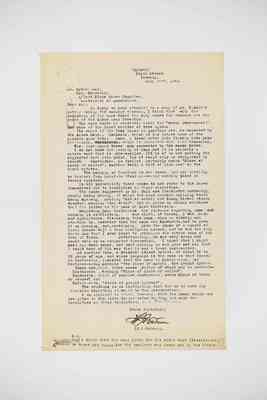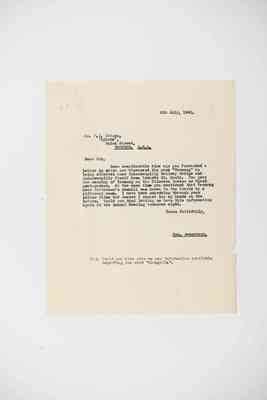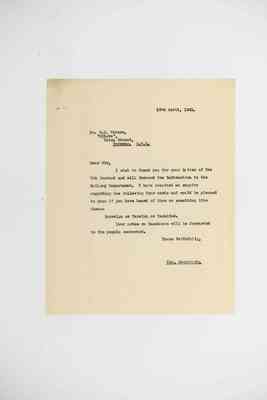Pages
36
Grosvenor Street, Toowong, S. W. 1. July 29th, 1940.
Mr. Sydney May, Hon. Secretary, Queesnsland Place Names Committee, University of Queensland.
Dear Sir,
I have to acknowledge the receipt of your letter of 18th instant advising me of my election as an Associate Member of the above-named Committee and inclosing a copy of its Constitution. Please convey to the Committee my thanks for the honour accorded me. I shall be pleased to continue my assistance in the objects of the Committee in any way possible.
Yours faithfully,
37
"Nyleta", Union Street, Toowong, July 14th, 1941.
Mr. Sydney May, Hon. Secretary, Q'land Place Names Committee, University of Queensland.
Dear Sir,
In reply to your attached to a copy of Mr. D. Bull's letter asking for comment thereon, I think that with the exception of the name Worri the only names for comment are the names of the Lakes near Tewentin.
The name Worri is evidently meant for "warui (war-oo-ee)", the name of the laced monitor or tree iguana
The names of the four lakes in question are, as recorded by the Lands Dept., Cooloola, which is the native name of the cypress pine tree; Como, a fresh water lake flowing into Lake Cootharaba, ? which is connected with Lake Cooroibah,
The last named three are connected by the Noosa River.
I do not know the meaning of Como, but it is probably a native word that is mis-spelled. (It is of no use putting the suggested word into print, for it could only be recognised by sound). Cootharaba, as spelled, certainly means "Place of clubs or nullas", coothar being a kind of club used by the local natives.
The meaning of Cooribah is not known, but may possibly be derived from kurui-ba (Kor-oo-ee-ba) meaning place of forest opossums.
In all probability these names do not refer to the lakes theselves but to localities in their vicinities.
The names suggeed by Mr. Bull are translated correctly, namely Koong Ubbung, of which the more correct spelling would Koong Ngabang, meaning "Mother water; and Koong Winwah (Koong wingwur) meaning "Big water", but he gives no actual evidence that the latter is the name of Lake Cootharaba.
Regarding Lake Cootharaba the evidence regarding name and meaning is conflicting. One night, t Cooroy, I was, with and acquaintance, discussing this name, when an elderly man standing by, asserted that the name was Kunduraba, but he gave it no meaning, but, continuing, gave the names of a number of local places with a true aboriginal accent, and he was the only white man that I ever heard to pronounce the native name of the town of Tiaro. Unfortunately, He was very drunk and could keep up no connected discussion. I hoped that I might meet him when sober, but next morning he was gone and all that I could hear of him was that he was a local bush-worker.
At another time, a Frazers' Island native, of about 60 to 70 years of age, and whose language is the same as that spoken at Cootharaba, insisted that the name is Kutchi-a-ba, (or Cootchee-a-ba), meaning "the place of kutchi, the ground iguana.
There are, thus, three names, either of which may be correct. -
Cootharaba, meaning "Place of clubs or nullas".
Kunduraba, which if spelled kundu-a-ba, means "place of boats or canoes"; and
Kutchi-a-ba, "Place of ground iguanas".
The evidence is so confliciting that for me to make any decision regarding it would be too presumptious.
I am inclined to think, however, that the names which are now given to the lakes do not refer to them but only too localities in their vicinities. [written in pencil] and Mestonian.
Yours faithfully [signature] (F.J. Watson).
P.S. I think that the name given for the spear wood (Dissilliaria Baloghiodes should be kauar, not hauer, for the aspirate was never u[s]ed by the blacks.
38
8th July, 1941.
Mr. F.J. Watson, "Nylota". Union Street, TOOWONG. S.W.1.
Dear Sir,
Some considerable time ago you forwarded a letter in which you discussed the name "Toowong" as being situated near Indooroopilly Railway Bridge and Indooroopilly itself down towards St. Lucia. You gave the meaning of Toowong as the Flinders Cuckoo or black goat-sucker. At the same time you mentioned that Toowong near Patterson's sawmill was known to the blacks by a different name. I have been searching through your letter files but regret I cannot lay my hands on the letter. Would you mind letting me have this information again at the Annual Meeting tomorrow night.
Yours faithfully.
Hon. Secretary.
P.S. Would you also give me any information available regarding the word "Moongalba".
39
10th April, 1941.
Mr. F.J. Watson, "Nyleta", Union Street, Toowong. S.W.1.
Dear Sir,
I wish to thank you for your letter of the 7th instant and will forward the information to the Railway Department. I have received an enquiry regarding the following four words and would be pleased to know if you have heard of them or something like them: -
Tarralyn or Taralun or Taralind.
Your notes on Beechmere will be forwarded to the people concerned.
Yours faithfully,
Hon. Secretary.
40
Union Street, Toowong, S.W.1. April 7th, 1941.
Mr. Sydney May, Hon. Secretary, Q.P.N. Committee, University of Queensland,
Dear Sir,
On the matter of the place name Beachmere, the following is a copy of a letter which I have received from Mrs. Ethel Smith, of Caboolture.
"From information gathered I think the first settler to take up land, extending from Toorbul point to King Johnny Creek, was a man named Bonney. Toorbul point later belonged to a man named Hamilton. From the scrubs around Cabulture township that is now, were cut the cedar and pine logs which were rafted down the Caboolture River to what is now called Beachmere Flats. With a pitsaw the logs were cut, the planks hand-dressed, and, on the bank at the mouth of the Caboolture River, Bonney built his homestead, naming it Beachmere; "Beach" on account of the narrow strip of sandy beach in front of the house, and "mere" because of the marshy nature of the land. Bonney died and was buried on the place and a Mr. Geddes then took over, and it was to this very homestead that my father (the late Mr. D.E. Boustead) brought my mother as a bride in the year 1880, my father being manager for Mr. Geddes at the time. the original homestead stood until a few years ago when it was demolished and rebuilt at what is now known as Beachmere Beach, a mile away from the first building site, only to be pulled down again and rebuilt in the town of Caboolture, the present owner being Mr. Mat. Zanow.
I believe a Mr. Arty Bonney (90 years of age), a son of the first settler, is at present living at Sandgate, although I have not been able to locate his proper address. Probably you could accomplish this with the aid of the Postal Department and he, no doubt, could give you much more valuable and useful information knowledge of the place.
(From)
[pencil comments] 4 copies




